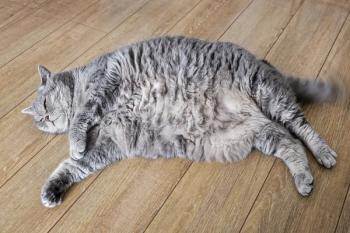
Feline idiopathic hypercalcemia (Proceedings)
Calcium in circulation occurs in three forms: calcium bound to proteins (approximately 40%), calcium complexed to various anions such as citrate and phosphate (8%), and ionized calcium (iCa, approximately 52%. The latter is the biologically active form of calcium and clinically-relevant hypercalcemia only exists when the ionized fraction of calcium is elevated.
Calcium in circulation occurs in three forms: calcium bound to proteins (approximately 40%), calcium complexed to various anions such as citrate and phosphate (8%), and ionized calcium (iCa, approximately 52%. The latter is the biologically active form of calcium and clinically-relevant hypercalcemia only exists when the ionized fraction of calcium is elevated. Total calcium (bound + complexed + ionized), which is reported on serum biochemical profiles, is influenced by serum protein concentrations, additional circulating complexes (as occurs in CKD), and acid-base status. Formulas to "correct" for serum protein concentrations have been shown to increase diagnostic discordance in both dogs and cats. In the clinically normal animal serum ionized calcium is typically proportional to the level of total calcium. However in the diseased animal serum ionized calcium is not proportional to total serum calcium and total serum calcium measurement cannot be used to predict serum ionized calcium concentration. Ionized calcium measurements are essential to make a diagnosis of hypercalcemia that is dangerous to the patient.
Calcium Homeostasis
The majority of calcium in the body is stored in the bone (>99%) with less than 1% in the extracellular fluid. Ionized calcium must be tightly regulated as it impacts numerous metabolic functions. Parathyroid hormone (PTH), calcitonin, and activated vitamin D (calcitriol) are the major hormonal regulators of calcium uptake, excretion, and storage. The main role of PTH is to increase serum calcium concentration which is achieved mainly by increasing osteoclast activity and release of calcium from bone. PTH also increased renal reabsorption of calcium and promotes phosphorous excretion. PTH also promotes the hydroxylation of 25-hydroxycholecalciferol to 1,25-hydroxycholecalciferol (calcitriol) and a calcitriol deficiency will increase release of PTH. PTH is stimulated by both decreased iCa and increased phosphorous. Calcitonin is released in response to increased iCa. It inhibits osteoclast activity and increases renal excretion of calcium. Calcitonin has limited biological potency. Vitamin D is obtained from food as cholecalciferol and has little biologic activity. It is hydroxylated first in the liver then in the kidney to 1,25-hydroxycholecalciferol (calcitriol), the most biologically active form. Hydroxylation in the kidney is limited by renal α 1 hydroxylase activity. This enzyme is stimulated by PTH and inhibited by hyperphosphatemia and less so by hypercalcemia. Calcitriol promotes intestinal absorption of calcium and phosphorous and at physiologic levels promotes bone calcification. In excessive amounts calcitriol promotes bone reabsorption. Other factors that impact calcium homeostasis include renal, hepatic, and GI function, adrenocortical hormones, thyroid hormone, serum sodium, phosphate, and magnesium concentrations. Bone contains exchangeable calcium for immediate buffering in addition to major storage capacity. The interplay of these systems is complex and complete understanding of calcium homeostasis is still deficient.
Idiopathic Hypercalcemia
Idiopathic hypercalcemia describes cats with hypercalcemia for which no underlying cause can be identified. Many causes of have been speculated including dietary factors (dietary acidification and metabolic acidosis, dietary magnesium restriction, hypervitaminosis D, hypervitaminosis A, and others), a genetic susceptibility, aluminum intoxication, hypoadrenocorticism, an abnormality in the calcium sensing receptor (on the parathyroid gland and the renal collecting tubule), a PTH mimetic, a vitamin D mimetic, a promoter of bone resorption, a stimulator of intestinal calcium absorption, etc and future studies are needed. This syndrome emerged in the early 1990's and has become, in the last decade, the most common cause of ionized hypercalcemia in cats in the United States.
Clinical Findings
Cats of any age may be affected. In one report the mean age was 5.8 years with a range of 2.0 to 13.4 years.1 Cats may appear clinically normal while some may exhibit non-specific signs including anorexia, weight loss, vomiting, constipation or diarrhea. Clinical signs may be waxing and waning. Some cats may be presented for signs of lower urinary tract disease associated with urolithiasis as these cats are predisposed to the development calcium oxalate stones from increased calciuresis. Some cats may be presented to the veterinary hospital for obstructive urolithiasis. Unlike in dogs polyuria and polydipsia is not a common clinical sign in cats with hypercalcemia. In one retrospective study reporting on 20 cats with idiopathic hypercalcemia (iCa), no cat had a presenting complaint of PU/PD. In this study 14 cats had a dietary history available and all 14 were being fed an acidifying diet to minimize struvite crystalluria and urolithiasis. Approximately 1/3 of the cats in this study had radiographic or ultrasonographic evidence of calculi (cystic, renal, ureteral) +/- nephrocalcinosis. Not all cats have diagnostic imaging performed (9/20 abdominal radiographs; abdominal ultrasound 15/20). In another retrospective study evaluating diseases that were diagnosed in 71 hypercalcemic cats approximately 24% of cats were described as polyuric and polydipsic.2 This study included cats with neoplasia, renal failure, urolithiasis, primary hyperparathyroidism, non-parathyroid endocrine disease, liver disease, post-renal azotemia, idiopathic lower urinary tract disease, bone marrow disease, infectious disease, and infectious/non-parathyroid endocrine disease. Many of the polyuric and polydipsic total hypercalcemic cats in this study also had a diagnosis of renal failure. Interestingly the cats with urolithiasis in this study had an unknown mechanism of hypercalcemia and the majority of those with calcium oxalate uroliths were not fed acidifying diets and few had a metabolic acidosis. Serum total calcium may be increased and serum ionized calcium is increased sometimes out of proportion to the decrease of increase of total calcium. Renal function based on BUN and serum creatinine is usually normal initially but chronic kidney disease will develop in some cats. Urolithiasis or nephrocalcinosis may be evident on diagnostic imaging.
Diagnosis
Diagnosis is based upon repeated detection of increased serum ionized calcium and exclusion of other causes of ionized hypercalcemia in cats (e.g. malignancy, primary hyperparathyroidism, vitamin D toxicosis, hypoadrenocorticism, granulomatous disease, hyperthyroidism, etc). There is usually a mild or moderate increase in calcium in cats with IHC and magnitude of increase does not correlate with clinical signs. Renal failure is reported to cause hypercalcemia in cats. In most cases of CKD in cats (but not always) total calcium may be elevated however the ionized fraction is in the normal range. In cats with chronic kidney disease hyperphosphatemia may be seen in addition to elevated PTH. A diagnostic challenge may be encountered in a patient with concurrent hypercalcemia and chronic kidney disease, with the later possibly a result of long standing hypercalcemia (chicken vs egg). Cats with idiopathic hypercalcemia will have low PTH levels or PTH that is in the lower half of the reference range. 25-hydroxycholecalciferol is usually in the normal range. Calcitriol measurements are not commercially readily available but have been reported to be normal.1 Diagnostic imaging may be pursued in an attempt to rule out lymphoma. In cats with hypercalcemia of malignancy phosphorous may be low. Other neoplasias that are more commonly reported to cause hypercalcemia in cats include squamous cell carcinoma especially in the head and neck region, and multiple myeloma. Fibrosarcoma, osteosarcoma, and bronchogenic carcinoma are rare causes of hypercalcemia in cats. In vitamin D toxicosis, 25-hydroxycholecalciferol will be elevated and hyperphosphatemia detected. Primary hyperparathyroidism is rare in cats. Cats with primary hyperparathyroidism may have PTH levels elevated outside the normal range or may have a PTH level that is in the upper normal or normal range. Serum phosphorous may be low or in the lower end of the reference range. Careful palpation of the cervical region is advised to evaluate for a cervical mass and ultrasonography of the cervical region is recommended to evaluate for a parathyroid mass (not always ultrasonographically obvious).
Effects of Hypercalcemia
Increased ionized calcium is associated with gastrointestinal signs including anorexia, vomiting, and constipation. Hypercalcemia can cause a reduction in smooth muscle contractility decreasing gastrointestinal motility increasing transit time and increasing calcium uptake by the intestine. In humans, hypercalcemia has been associated with pancreatitis; in experimental cats, IV infusions of calcium gluconate into the splenic artery and jugular vein have been shown to induce pancreatic acinar destruction experimentally in cats. Ionized calcium increased by 1.8 times with systemic infusion. This degree of hypercalcemia is much higher than produced in most pathologic causes of hypercalcemia in cats, especially IHC. As stated earlier cats with hypercalcemia are predisposed to calcium oxalate urolith formation and all cats with urolithiasis should be evaluated for hypercalcemia by measuring a serum iCa concentration. Renal damage and chronic kidney disease can be a consequence of hypercalcemia.
Treatment (what we do)
Since cats with IHC typically have mild to moderate elevations in iCa, immediate therapy to reduce serum calcium such as IV fluid diuresis, +/- loop diuretics, +/- IV bisphosphonates are not usually needed.
There is currently no consensus about how to manage these patients or when intervention is necessary. Intervention may be recommended in all cases of IHC, even in those cats that are not exhibiting clinical signs to avoid complications of hypercalcemia that may eventually happen. Interventional therapy for IHC in cats traditionally consists of dietary modification, followed by glucocorticoid administration, followed by oral bisphosphonate therapy. Oral bisphosphonates are sometimes used instead of glucocorticoids.
Dietary modification
Attempts to reduce serum calcium concentration are sometimes successful following dietary modification in cats with idiopathic hypercalcemia – the mechanism for this beneficial effect has not been specifically studied. Mechanisms that could be operative include reduced intestinal absorption of calcium and reduced bone resorption of calcium. Intestinal absorption of calcium depends on the amount and bioavailability of calcium, dietary fiber type, the amount of fiber, and also other nutrients present in the diet. Feeding of increased dietary fiber has been reported to restore normocalcemia in some cats with IHC and calcium-oxalate urolithiasis3,4 but not in another study. Intestinal absorption of calcium may be decreased with the feeding of high fiber diets by decreasing the gastrointestinal transit time. Most pet food manufacturers have taken this potential decrease in absorption of calcium into account, and have increased the quantity of dietary calcium in high fiber diets to enhance calcium absorption. Serum ionized calcium concentration and the degree of calciuria is increased in cats that eat acidifying and Mg restricted diets5 It is possible that in some cats hypercalcemia will resolve when fed a less acidifying diet. Renal diets are less acidifying and possibly alkalinizing so these may be chosen as therapy, but their degree of phosphorus restriction may enhance calcitriol synthesis that could blunt the salutary effects of the alkalinization.
Prednisolone Administration
If dietary change fails, prednisolone administration is considered. Glucocorticoids can lower circulating calcium levels through effects on bone by reducing bone resorption, the gastrointestinal tract by decreasing intestinal absorption of calcium and on the kidney by increasing renal excretion of calcium. Increase renal excretion of calcium has the potential to aggravate hypercalciuria and calcium oxalate urolithiasis.
Oral Bisphosphonate Therapy
Bisphosphonates are organic pyrophosphate analogues that inhibit bone resorption following deposition into areas of active bone turnover. Their presence in bone interferes with hydroxyapatite dissolution and exerts direct effects that reduce osteoclastic function. Induction of osteoclast apoptosis appears to be the main effect of bisphosphonates.6 Intravenous administration of bisphosphonates is preferred over oral administration for treatment of severe hypercalcemia as some patients will be vomiting and cannot tolerate oral medication. Bisphosphonates are very poorly absorbed across the GI tract – usually less than 5% is absorbed and this can decrease to nearly zero with food in the stomach at the time of administration. There is limited information about the use of oral bisphosphonates in general, and none for control of hypercalcemia specifically reported in dogs or cats. A small number of cats with odontoclastic resorptive dental lesions was treated with oral alendronate at 9 mg/kg twice weekly orally for 27 weeks without development of adverse effects.7 Once weekly oral alendronate reduced serum ionized calcium concentration in most cats with idiopathic hypercalcemia (IHC) in a pilot study conducted at The Ohio State University VMTH (Dr. Brian Hardy unpublished observations). No side effects were documented in the 6 months of this study with an average weekly dose of 10 mg per cat. Care should be taken to ensure that tablet medication does not stick in the esophagus, as this is a known risk for erosive esophagitis in humans. Tap water PO following pilling is recommended to help lessen this possibility as is "buttering" of the lips to encourage salivation, swallowing, and increased transit of pills into the stomach. Oral bisphosphonate treatment can restore normocalcemia in some cats that fail to do so during diet and prednisolone treatment. Some cats have required up to 30 mg weekly per cat to achieve normocalcemia. Oral bisphosphonate treatment has failed to achieve normocalcemia in a small number of cats with IHC. Several cats have been on alendronate treatment for years without known adverse effects. We have observed one cat with IHC to develop Hypocalcemia and clinical signs. The salutary response during bisphosphonate treatment indicates that blunting of osteoclastic bone resorption can be effective to decrease serum ionized calcium but it does not prove that accelerated bone resorption is the underlying cause of IHC.
References
1. Midkiff AM. J Vet Intern Med 2000;14:619-26.
2. Karine C.M. J Vet Intern Med 2000;14:184-189.
3. Osborne CA. Vet Clin North Am Small Anim Pract 1996;26:217-32.
4. McClain HM. J Am Anim Hosp Assoc 1999;35:297-301.
5. Ching SV. J Nutr 1989;119: 902-915.
6. Body JJ, Coleman RE, Piccart M. Use of bisphosphonates in cancer patients. Cancer Treat Rev 1996;22:265-287.
7. Harvey CE, Mohn KL, Jacks TM, Schleim KD, Miller B, Feeney WP: Alendronate binds to periosteal bone and inhibits progression of feline odontoclastic resorptive lesions in cats. Dental Service, Department of Clinical Studies, School of Veterinary Medicine, University of Pennsylvania, and Merck Research Laboratories, Rahway, NJ, 2004.
8. Cook AK, Cats and calcium: the causes and consequences of hypercalcemia. Proceedings 2009 ACVIM Forum, Montreal, QC. p429-421.
Newsletter
From exam room tips to practice management insights, get trusted veterinary news delivered straight to your inbox—subscribe to dvm360.






